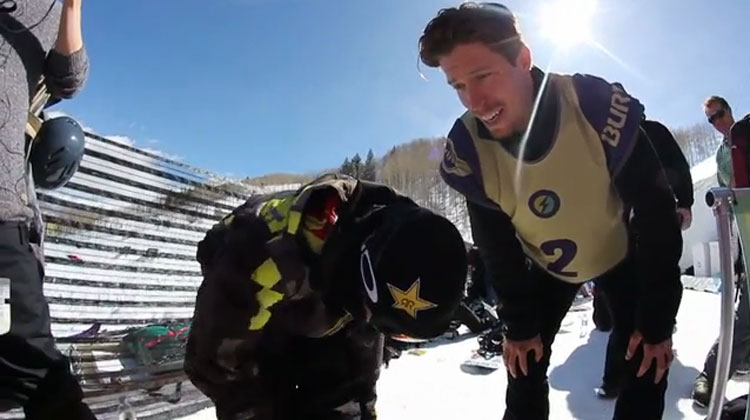Taken from Whitelines 105, December 2012
Words by Craig McDougall
Photos by Craig McDougall and Ben Stott
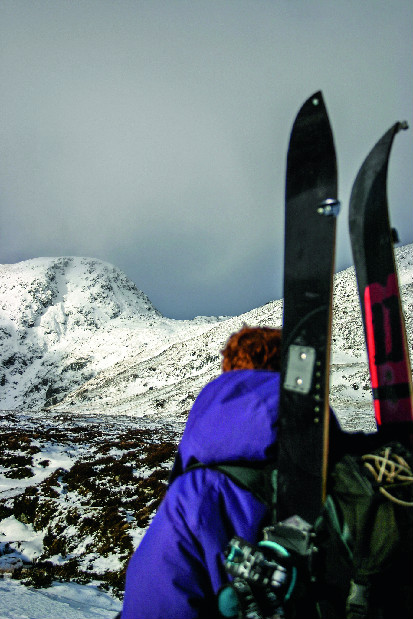
Backcountry exploration, steep faces and first descents – who said freeriding meant going abroad? Two ordinary blokes test the untapped potential of Scotland.
I knew from the look on Ben’s face that I should probably stop laughing. He was normally so chilled, but the expression of panic was a concern. One second I’d been traversing, the next a frozen section of windslab had demonstrated the limits of my boots’ grip, and I was now sliding headfirst on my back at increasing speed. It was fun – until the realisation kicked in that I was no longer at a regular Scottish ski centre but halfway up a mountain in a remote area of the Highlands, and I had no idea what was at the end of this steep, icy slide.
* * *
We were on our maiden mission up a sizeable Scottish mountain, the name of which I couldn’t even pronounce properly. In my head, splitboarding was going to be all about scoring monster lines in the backcountry and a little ski touring in- between. In reality it was turning out to be serious winter mountaineering, for which we were just not prepared.
Skipping back a few months, like so many others I had become obsessed with the dream of doing a season and chasing some powder. Unfortunately, my bank balance laughed at the idea. Living in Scotland however, I was convinced that there was untapped shred potential in the Highlands. Just imagine how some of the bowls I’d seen on summer hikes would look full of powder – how could it be anything but epic?! Not having a snowmobile or a spare heli lying around, I started looking into the other options. The whole snowshoe thing just did not appeal, nor did proper ski touring. Thankfully a YouTube clip ofMr Jeremy Jones riding something called a splitboard found its way onto my computer, and my whole plans for the winter changed.
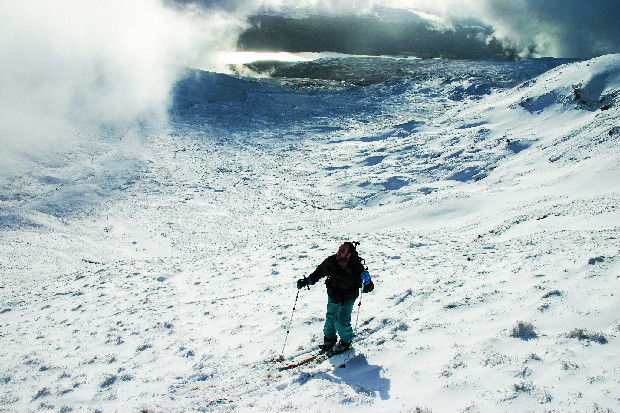
A splitboard is a snowboard that splits in two along the centreline to form two skis. It has special binding mounts that allow you to telemark up the hill cross-country style, before clipping the board back together or the ride down. Slap a pair of furry climbing skins on the base and you are in full backcountry business. It is not as glamorous as heli-boarding or as thrilling as driving a sled, but you earn your lines and you can always claim some eco-friendly points with your local hippy.
Picking up a commercially made splitboard is easy and the tech specs are sweet, but like all specialised kit it comes with a hefty price tag. Whilst browsing some of these beauties I stumbled on the holy grail: one ‘split kit’ by a company called Voile. Turns out they were my kind of brand, allowing me to fulfil all my Blue Peter dreams and build my own – so long as I could overcome the mental barrier of taking a circular saw with carbide tip blade to my beloved pow stick. After some further online research and a chat with Steve at The Sick and the Wrong shop in Cumbria, I was ready to roll.
So much of the time the grass seems greener elsewhere; last season, I was able to appreciate what’s on our doorstep
Ben Stott and I were introduced by a mutual friend who was like, “You should meet my mate, he’s stupid enough to trash his snowboard too!” Everyone else had been so negative about the idea, but as soon as I met Ben things started to get out of hand quickly. Within a couple of weeks we had sliced our boards, attached a collection of clips and thrown around serious amounts of epoxy. Our heavily doctored boards were as ready as they were going to get, and we spent days oggling over Ordnance Survey maps and winter walking forums while we waited for the snow to arrive.We had picked our first target location and were pretty optimistic about how things were going to go.
D-Day finally arrived. Fully stoked, we rocked up at the car park at the bottom of our first munro and instantly felt like total punters. The two of us were getting some serious stares. It seems our regular brightly coloured snowboard gear, fully legit on any piste, was a warning sign to the seasoned winter climbers saying ‘no idea what I am doing’.
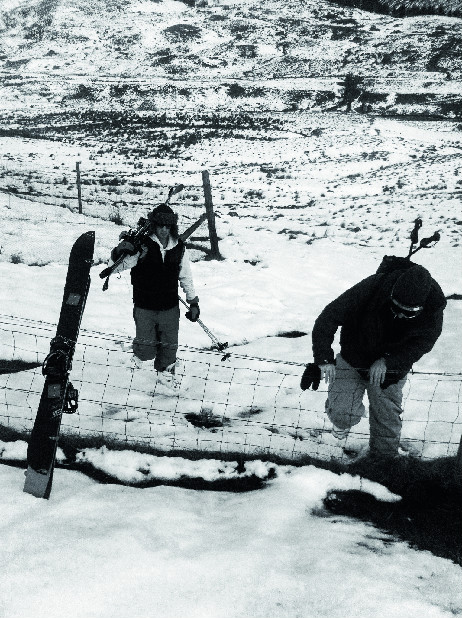
Despite all our practice at home, that first time assembling the kit in the cold was pretty tricky. The ice climbers walked by – ignoring us as best they could – while the ski tourers looked on amused as we fumbled with our skis. After a while, the serious expressions of all the other folk made us think: did they know something we didn’t, or were they generally just pretty grim characters? It made no odds. We were having fun figuring out how to put it all together and, feeling like Scott and Amundsen racing for the South Pole, we began our first ascent.
One thing Ben and I definitely are not is skiers, something which was shown up within an hour of splitting. Progress was slow as we laughed at each others’ face plants and slipped, slid and spread-eagled our way up the hill, but after a while we got into it – just as well since we’d invested a lot of time and money in this project.
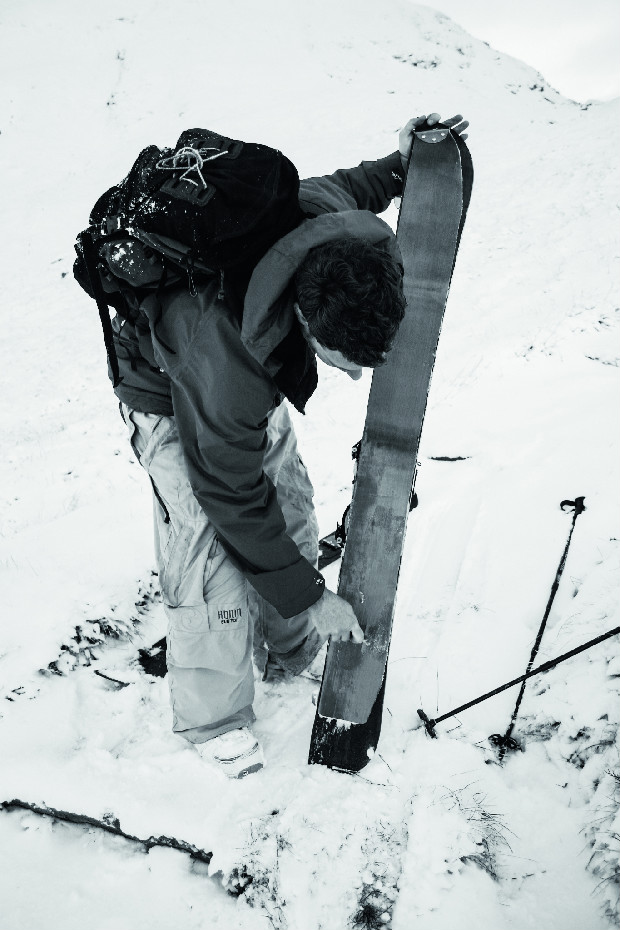
Those clean expanses of freshies were now within reach, and when we finally began storming our first lines on homemade boards the stoke levels reached capacity. The hike was all but forgotten, replaced by smiles and woops, and the crash test was complete. We now felt ready to tackle our first proper bit of backcountry – which is how, a short while later, I came to be sliding backwards down a sheer wall of ice…
Winter apparently has no respect for the ill-equipped and inexperienced. In hindsight, purchasing an ice axe and crampons would have been a good call, but I improvised and somehow managed to arrest my fall by ramming my board’s edge into the face. I was still laughing until I saw the huge drop below and the blood drained out of me. It turns out splitboarding has a bit of a learning curve, and I had been lucky. Thankfully it doesn’t take long to recover from a near-death experience – especially when in the next breath you’re fully buzzing from hitting your best ever UK line. Pandora’s Box was now wide open.
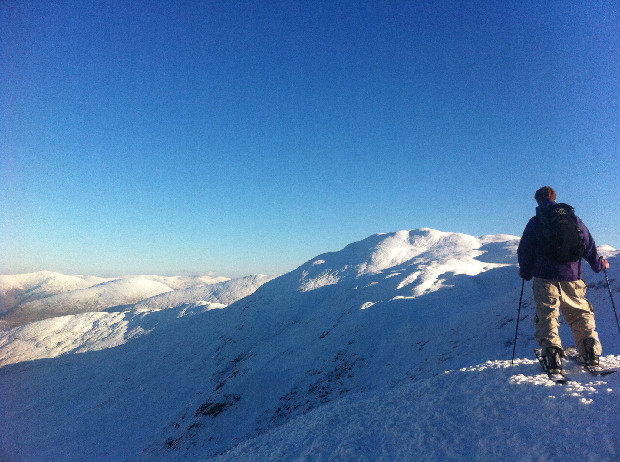
After a few more outings we quickly began to amass some ‘experience’ and developed a few golden rules, which were learned the hard way. Start by ensuring you’ve got all the correct kit to be out in the middle of nowhere during winter – we’re talking avy gear, maps, G.P.S. and first-aid kit, plus warm layers and grippy stuff. Without these items, the lack of a familiar ski patrol or café will ensure you’re screwed before you begin.
Second, it might seem obvious but to gain a few metres of elevation over a short distance you should always split it. An easy-looking walk is always slower and more exhausting than you’d think. Third, check what’s under foot and make a good route choice. No matter how well frozen that patch of water looks, walk around it – the ice will crack and you will fall in. This was more Ben’s rule after an unplanned water splash, but I stuck to it because of how cold and pissed off he looked.
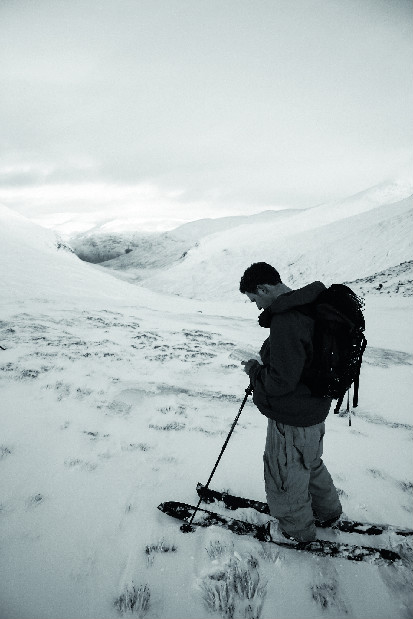
Carry some spare parts and tools to bodge things – it’s worth the extra weight. I snapped a pole and the day was only saved by my pocket multi-tool and a persuasive rock. Next, pack that spare pair of gloves, goggles and a hat, as mountains often have an evil wind and things suddenly disappear. Strap’em down while you’re at it. Finally, take that second glance back at the car in the morning, as it’s a feeling of dread when you return knackered at the end of a day to find you left the lights on.
This splitboarding malarkey had appeared so easy on YouTube and there were no books to tell us otherwise. We really hadn’t anticipated the effort it takes to get up a mountain in snow and ice, or how risky things get when you become fatigued. As the season progressed however, new knowledge began sweeping in. Beards became pretty reliable altimeters, always freezing at a height of 900m. Lunch sizes grew, and we were easily drinking our two-litre Camelbaks of water without a piss all day. We developed clothing layering strategies to account for the very noticeable temperature changes experienced at each stage between the bottom and top of the hill. We were glued to mountain weather reports, OS maps and avalanche forecasts. Lots of things were changing and the days of rocking up at a resort, slapping down your thirty quid and shredding seemed a long way away.
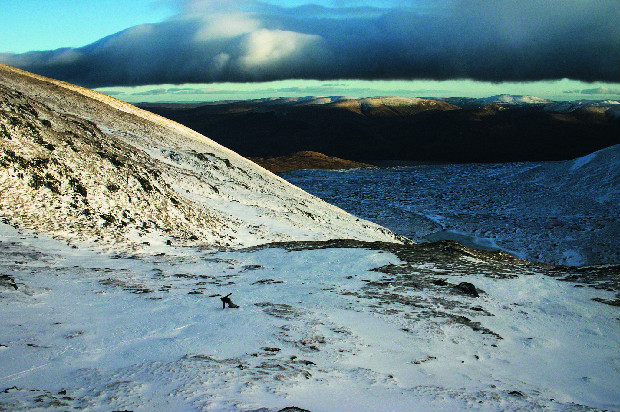
Before we started this adventure, I remember looking at websites saying, “Yeah, I’m pretty sure a grade one ice climb shouldn’t be a problem.” I soon learned otherwise, and we quickly learnt to be flexible with our objectives in general. “Have fun, but make it home in one piece” was the order of the day. Knowing when to admit defeat and adapt the plan was vital. Soon, we were making some serious route decisions for ascents and descents in difficult terrain. We were no longer two independent shred rats, we’d become our own micro team. What one decided to do would always impact on the other. Out here the car could be hours away, so messing up wasn’t an option – and we weren’t about to find out how quickly the mountain rescue can find your pal’s frozen bones. Above all, we developed a true respect for the mountains.
Last season was icier, windier, harder and scarier than either of us could have ever anticipated. Saying that, we scored the best lines and had the most fun either of us had experienced in this country. It opened our eyes to the massive potential splitboarding has to offer at home in the UK. This is snowboarding in its raw adventure form. So much of the time the grass seems greener elsewhere and we want to disappear for trips abroad; last season, I was able to fully appreciate what is on our doorstep. Water the grass under your feet and see how green it grows: build a splitboard.


